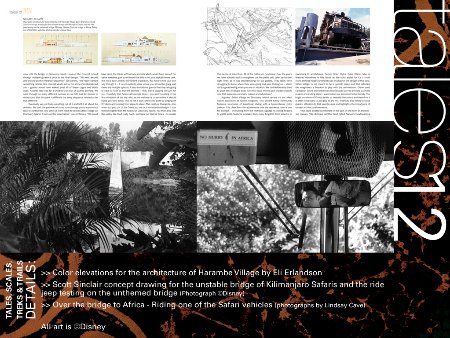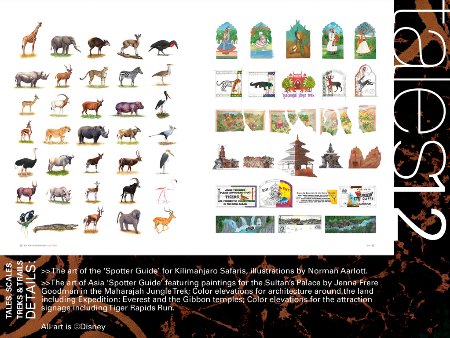Disney's Animal Kingdom at Ten
Page 3 of 5

Click here for a much larger version of this picture
Safari Village is not meant to be a specific place and that afforded the imagineers a freedom to play with the architecture. Senior Color Stylist Katie Olson used Caribbean colors and references like Oaxacan carved animals to create a warm and inviting place � warm colors are perceived to be friendly. �That style existed somewhere in the park in one form or another,� Joe reveals. �We did have another land called Nature�s Headquarters that was to be our Epcot pavilion. This was where guests would learn about animals. The island had a more grand architectural treatment to it � like a mix of Stonehenge and Communicore [now Innoventions at Epcot] but that didn�t play out and we ended up getting rid of that land entirely. However we liked the aesthetic look and put it on the island instead. We wanted to develop this harmony and resonance between the tree as this natural object that expresses the beauty, diversity and wonder of animal life on earth and the village that is man-made but expresses the same thoughts. So the island expresses both visually. The palette is not geographic specific but it is thematic specific to the idea of the tree. We used these great bright tropical Oaxacan colors that make guests think they are in the tropics. All of the lands are so driven to being unbelievably real that it was important to have a neutral center that you go back through on multiple occasions to rebase and recharge.�

Click here for a much larger version of this picture
As Joe succinctly puts it �every park needs an icon if only for navigation.� However much like the entrance sequence it was not immediately apparent that the Tree of Life was the most appropriate device. �The first proposal for a centerpiece to the park was a more cold-blooded marketing-driven proposal � it was this amazing wedding cake-like flying and swimming carrousel. It was six layers of carrousel stacked up with flying animals on articulated arms,� Joe exclaims. �It was this huge swirling thing but as the park evolved it became too frivolous as an icon. We had a smaller version of the tree in the Nature�s Headquarters land which was probably the size of Tarzan�s Treehouse [at Disneyland]. We like the idea and moved it to the center of the park but it then became this giant thing that became an engineering nightmare.�
The original opening day menu called for a restaurant space and a walk-through up the tree itself. However it became apparent late in the design process that Animal Kingdom needed more shows. �I don�t think it is well understood outside of our industry how these things work � you don�t just come up with an idea and then build it,� Joe rationalizes. �You tend to think up a web of ideas, many of which will never happen and you don�t know which of them will work. It is a grid of opportunity and challenge � almost like a complicated Darwinian chess game. You know that one idea will never survive but you change this tiny detail and keep pushing hard for it until you actually get the money to build it. When the restaurant idea went away we had this big empty space inside the Tree of Life. We came up with twenty ideas and then landed on It�s Tough To Be A Bug as Michael [Eisner] had just seen an edit of A Bug�s Life up at Pixar. So we pushed that show into development but we still needed dining on Discovery Island so the amphitheater that overlooked the lake in our original menu gave way to Flame Tree Barbeque. We often come up with these great perfectly deliverable ideas that work like a clock but you can take money out of them and use it on another idea which might not be as good but is absolutely necessary to the makeup of the park. You have to balance it out as the whole thing needs to work.�
